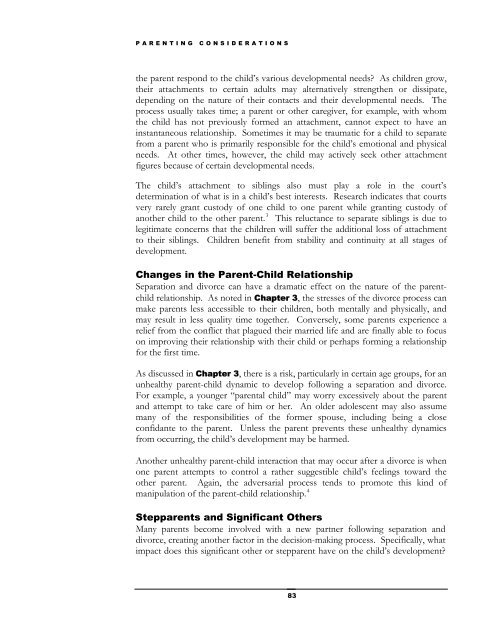A Judge’s Guide
A Judge’s Guide
A Judge’s Guide
Create successful ePaper yourself
Turn your PDF publications into a flip-book with our unique Google optimized e-Paper software.
PARENTING CONSIDERATIONS<br />
the parent respond to the child’s various developmental needs? As children grow,<br />
their attachments to certain adults may alternatively strengthen or dissipate,<br />
depending on the nature of their contacts and their developmental needs. The<br />
process usually takes time; a parent or other caregiver, for example, with whom<br />
the child has not previously formed an attachment, cannot expect to have an<br />
instantaneous relationship. Sometimes it may be traumatic for a child to separate<br />
from a parent who is primarily responsible for the child’s emotional and physical<br />
needs. At other times, however, the child may actively seek other attachment<br />
figures because of certain developmental needs.<br />
The child’s attachment to siblings also must play a role in the court’s<br />
determination of what is in a child’s best interests. Research indicates that courts<br />
very rarely grant custody of one child to one parent while granting custody of<br />
another child to the other parent. 3 This reluctance to separate siblings is due to<br />
legitimate concerns that the children will suffer the additional loss of attachment<br />
to their siblings. Children benefit from stability and continuity at all stages of<br />
development.<br />
Changes in the Parent-Child Relationship<br />
Separation and divorce can have a dramatic effect on the nature of the parentchild<br />
relationship. As noted in Chapter 3, the stresses of the divorce process can<br />
make parents less accessible to their children, both mentally and physically, and<br />
may result in less quality time together. Conversely, some parents experience a<br />
relief from the conflict that plagued their married life and are finally able to focus<br />
on improving their relationship with their child or perhaps forming a relationship<br />
for the first time.<br />
As discussed in Chapter 3, there is a risk, particularly in certain age groups, for an<br />
unhealthy parent-child dynamic to develop following a separation and divorce.<br />
For example, a younger “parental child” may worry excessively about the parent<br />
and attempt to take care of him or her. An older adolescent may also assume<br />
many of the responsibilities of the former spouse, including being a close<br />
confidante to the parent. Unless the parent prevents these unhealthy dynamics<br />
from occurring, the child’s development may be harmed.<br />
Another unhealthy parent-child interaction that may occur after a divorce is when<br />
one parent attempts to control a rather suggestible child’s feelings toward the<br />
other parent. Again, the adversarial process tends to promote this kind of<br />
manipulation of the parent-child relationship. 4<br />
Stepparents and Significant Others<br />
Many parents become involved with a new partner following separation and<br />
divorce, creating another factor in the decision-making process. Specifically, what<br />
impact does this significant other or stepparent have on the child’s development?<br />
83


